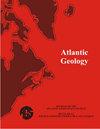Investigation of the Cape Fear arch and East Coast fault system in the Coastal Plain of North Carolina and northeastern South Carolina, USA, using LiDAR data
IF 0.9
4区 地球科学
Q2 GEOLOGY
引用次数: 1
Abstract
LiDAR data collected in the Coastal Plain of the Carolinas revealed numerous, mostly NW-SE-oriented lineaments that cross the Cape Fear arch, the longest of which are the 50- to 115-km-long, NW-SE-oriented Faison, Jarmantown, Livingston Creek, and White Marsh lineaments and the ~50-km-long, ENE-WSW-oriented Tomahawk lineament in southeastern North Carolina. Their interpretation is based mainly on locally incised channels, abrupt stream bends, topographic scarps, and linear areas of uplifted Coastal Plain sediments. The Precambrian to Paleozoic Graingers basin or synform in the pre-Cretaceous basement terminates to the southwest along the ~28-km-long, 3- to 7-km-wide Jarmantown high. The ~115-km-long Jarmantown lineament may be the surface expression of the previously reported Neuse fault, the location of which has been controversial. The Jarmantown and other lineaments crossing the Cape Fear arch suggest that the arch is structurally complex. Further investigation of the East Coast fault system (ECFS) along the west side of the Cape Fear arch in North Carolina revealed that it is located farther to the northwest than previously reported, thereby making it continuous with the ECFS in northeastern South Carolina where it forms a ~15° restraining bend. We postulate that the interpreted faults crossing the Cape Fear arch in southeastern North Carolina formed to compensate for the increased compression and change in volume from dextral motion along the fault bend. Holocene paleoliquefaction deposits near the coast, a vertically offset Pleistocene(?) beach ridge along the interpreted Faison fault, and Tertiary surface faults along the ECFS northeast of Smithfield, North Carolina, suggest that large Quaternary earthquakes may have occurred along the ECFS, the Faison and Neuse faults, and other interpreted faults that cross the Cape Fear arch.利用激光雷达数据对美国北卡罗来纳州和南卡罗来纳州东北部沿海平原的Fear角拱和东海岸断层系统进行调查
在卡罗莱纳州海岸平原收集的激光雷达数据显示,许多主要是西北-东南走向的线理穿过恐惧角拱门,其中最长的是50至115公里长的西北-东南方向的Faison、Jarmantown、Livingston Creek和White Marsh线理,以及北卡罗来纳州东南部约50公里长的东北-西南走向的Tomahawk线理。它们的解释主要基于局部下切河道、陡峭的溪流弯曲、地形陡崖和隆起的海岸平原沉积物的线性区域。前白垩纪基底中的前寒武纪至古生代Graingers盆地或同形面沿约28公里长、3至7公里宽的Jarmantown高地向西南终止。约115公里长的Jarmantown线性构造可能是先前报道的Neuse断层的表面表现,其位置一直存在争议。Jarmantown和其他穿过Cape Fear拱门的线性构造表明该拱门结构复杂。对北卡罗来纳州费尔角拱西侧的东海岸断层系统(ECFS)的进一步调查显示,该断层系统比之前报道的位置更西北,从而使其与南卡罗来纳州东北部的ECFS连续,在那里形成约15°的约束弯曲。我们假设,穿过北卡罗来纳州东南部Fear角拱的已解释断层的形成是为了补偿沿断层弯曲右旋运动增加的压缩和体积变化。海岸附近的全新世古液化沉积物,沿解释的Faison断层的垂直偏移更新世(?)海滩山脊,以及沿北卡罗来纳州Smithfield东北部的ECFS的第三纪表面断层,表明沿ECFS、Faison和Neuse断层以及其他穿过Fear角拱的解释断层可能发生了第四纪大地震。
本文章由计算机程序翻译,如有差异,请以英文原文为准。
求助全文
约1分钟内获得全文
求助全文
来源期刊

Atlantic Geology
GEOLOGY-
CiteScore
2.10
自引率
18.80%
发文量
0
审稿时长
>12 weeks
期刊介绍:
Atlantic Geology (originally Maritime Sediments, subsequently Maritime Sediments and Atlantic Geology) covers all aspects of the geology of the North Atlantic region. It publishes papers, notes, and discussions on original research and review papers, where appropriate to the regional geology.
 求助内容:
求助内容: 应助结果提醒方式:
应助结果提醒方式:


